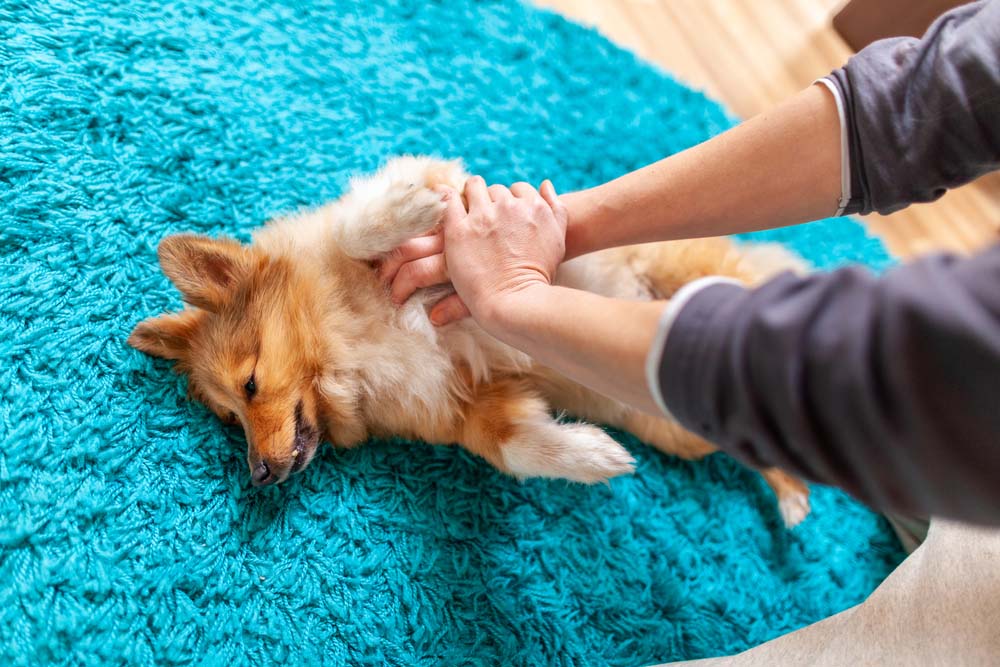
Learn how to give first aid to help save your dog’s life
Read Time: 5 minutes
A vital part of keeping your dog safe is knowing how to respond in emergencies. Administering first aid can help save their life, especially in instances when waiting for a vet might take too long. Let’s break down the most common types of emergencies and what to do to help your dog.
What to Do When Your Dog Has an Emergency

The most important thing to do when your dog has an emergency is to remain calm and act rationally. This can be difficult when you are panicked or scared, so it’s best to be prepared. First aid will not always solve your dog’s underlying problem. The main purposes of first aid are to preserve your dog’s life, reduce their pain and discomfort, and minimize any risk of disability or disfigurement.
Start by taking the following steps:
- Assess the scene: Determine what is affecting your dog and ensure there are no ongoing threats to your pet’s or your safety (such as an attacking animal or fire)
- Keep your dog safe: Make sure your dog is as warm and quiet as possible by using blankets or clothing, and keep their movement to a minimum, especially if they are injured
- Contact your vet: Call your veterinarian or local animal hospital and tell them what happened. If immediate care is needed, they can offer you advice over the phone
Restraining a Dog
Sometimes you will need to restrain your dog if they are panicking. Be as calming and gentle as possible. You may have to muzzle them (unless they are choking or experiencing heat stroke) to prevent them from biting you. You can use a leash, belt, sock, or rope to create a makeshift muzzle. Then wrap them in a blanket or towel, keep the head exposed, and do not block the dog’s airways. If you are nervous about a spinal injury, immobilize the dog using cords or straps, but be careful around their head and neck.
How to Respond to Different Emergencies
Your next steps will depend on what type of emergency your dog is experiencing.
Injuries Such as Fracture or Broken Bones
If your dog appears to have fractured or broken bones, follow these steps:
- Try to immobilize the dog as quickly as possible. If your dog is small enough, you can put it in its carrier – but put it in through the top, not the side door, to prevent further injuries. Larger dogs might need a makeshift stretcher, which you can make out of a large piece of wood.
- Use a blanket to move the dog onto the stretcher or into the carrier.
- Carefully transport your dog into the car and to the vet.
Bleeding

If your dog is bleeding, utilize a dressing, piece of clothing, or absorbent bandage to apply pressure and stop the bleeding. Hold the dressing with pressure for several minutes before checking to see if the bleeding has stopped. If it continues, get to a vet as quickly as possible to minimize the risk of infection. In severe situations, you can apply a tourniquet using an elastic band or gauze.
Shock
Sometimes dogs go into shock, which is a reaction due to emergency situations such as trauma, loss of blood, or heart failure. Symptoms include:
- Rapid breathing
- Elevated heart rate
- Pale mucous membranes (lips, gums, eyelids)
- Cold feet and/or ears
- Shivering
- Vomiting
Shock can be fatal, so it is vital to take action as quickly as possible. Your dog might become quiet and unresponsive as the shock continues. Follow these steps:
- Restrain the dog as described earlier
- Keep the dog warm and quiet
- Keep the head level with the rest of the body if the dog is unconscious
- Transport to a vet immediately
If your dog is in shock, they also risk choking or not breathing. We describe how to respond to these problems below.
Choking
Choking is a serious hazard to your dog’s health. Symptoms include retching, excessive pacing, and pawing at the mouth. Your dog might not produce any sound if the airway is totally blocked. Follow these steps:
Clear the Airway
- Open your pet’s mouth to view their airway, carefully avoiding panicked biting.
- If your pet is still breathing, it’s best to start driving to a veterinarian or call one to you at this point.
- Look for obstructions such as vomit or foreign bodies.
- If you see an object, remove it with tweezers or forceps. Try not to use your fingers as you can more easily push the object further in this way.
- Note that some dogs have an additional cavity at the top of their mouth that you should check.
- If you can’t remove the object, can’t see it, or believe there is something large stuck in your dog’s airway, you can place your thumbs underneath their jaw at the base of their throat, apply pressure and push forwards to dislodge the item.
- If this doesn’t work, lay your dog on their side and gently pump the chest with the palm of your hand.
- You can also try removing an object by turning the dog upside down, with its back to your chest, and applying five sharp thrusts to the abdomen to expel the object.
Check for Breathing and Pulse

- If you fear your pet is not breathing, check for a heart or a femoral pulse. This pulse is found in the upper third of the back leg, near the groin. Use your fingers instead of your thumb since your thumb has a strong pulse of its own.
- If your dog is not breathing, perform rescue breathing.
Perform Rescue Breathing
If your dog is not breathing, you should begin rescue breaths before beginning CPR. Follow these steps to perform rescue breathing:
- Ensure there is an open airway by pulling out the tongue and extending the head and neck in a straight line unless the dog has severe head trauma.
- Close your dog’s mouth shut and extend the neck.
- Blow into the dog’s nostrils, 2-3 breaths at a time, until you see the dog’s chest expand. Then continue with a rescue breath once every 4-5 seconds.
- If the chest does not rise, reposition the neck and search again for airway obstructions.
- If your chest has no heartbeat, start CPR (read below) while continuing rescue breaths.
How to Give a Dog CPR
If your dog has no pulse or heartbeat, you should begin administering CPR.
- Make sure there is no major bleeding.
- Lie the dog on their right side.
- Bend the dog’s left forearm. The place where the elbow touches the chest indicates the middle of the ribcage, where the heart is.
- Place one hand on either side of this part of the ribcage. For small dogs, you may use one hand with the thumb on one side and the fingers on the other.
- Compress the chest 80-120 times per minute for larger dogs and 100-150 times per minute for smaller dogs.
Note: you should not perform chest compressions and rescue breathing at the same exact time. You should alternate between them or work with another person. One person can do the chest compressions for four to five seconds, then stop long enough for the other person to give one rescue breath. Continue until you hear a heartbeat and the pet is breathing normally.
Burns/Scalds
If your dog has been burned or scalded, cool the burned area with cold water as soon as possible. Cover the burned area with damp towels. If the burn was caused by something potentially hazardous, rinse for 15 minutes and call your vet ASAP. If the dog was exposed to smoke or fire, give them water to drink as soon as possible.
Eye Injuries
If your dog has something in its eye, try to rinse it out with an eyewash or a contact saline solution, as long as saline is the only ingredient. Don’t let your dog rub its eye and get it to the vet as soon as possible.
Seizures
Keep the seizing dog in a dark, quiet, and confined area away from furniture or other dangers until you can get medical attention. Do not try to get into their mouth as they will likely bite you. Time the seizure. After it is over, keep them as warm as possible until you get to the vet.
Sometimes, nursing mothers can seize due to eclampsia. If this is the case, take the nursing puppies off the mother as soon as possible.
Heat Stroke

Heat stroke is a largely preventable ailment, but it’s important to know how to respond if it does happen. Signs of heat stroke include excessive panting and obvious distress. Follow these steps:
- Get the dog into a cool and shaded place as soon as possible.
- Reduce the dog’s body temperature using cool – but not ice-cold – water. You can pour water over the dog or use cold, wet towels.
- Keep the dog wet during transport to the vet.
- Keep the car’s windows down as evaporation can help reduce your dog’s body temperature.
Your Dog May Have Eaten Something Poisonous
Call your vet immediately, do not make your dog throw up, and do not let them groom. Read our blog post on potential poisoning for detailed instructions.
How to Prepare Yourself for an Emergency
To prepare for future dog emergencies, keep your vet’s number and address in your phone and somewhere easily accessible in the house. Keep a pet first aid kit in your home and your car. Additionally, consider taking a pet CPR or first aid class to learn life-saving skills.

Concerned about your pet’s health?
Contact us
If you have any questions about your cat’s behavior, please call our clinic at (407) 352-2579. We’ll help you through it.




